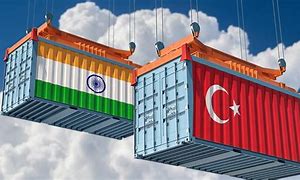India Moves to Cut Trade with Turkey and Azerbaijan Amid Diplomatic Tensions

READ MORE HERE: https://newsorgames.com/
New Delhi, May 2025 — In a decisive shift in foreign trade policy, India is reportedly preparing to scale down trade relations with Turkey and Azerbaijan, citing increasing diplomatic friction and alignment of both nations with Pakistan on issues sensitive to Indian sovereignty.
The move, which comes amid broader recalibrations of India’s foreign policy architecture, signals New Delhi’s willingness to use economic tools as leverage in regional diplomacy.
🇮🇳 Why India Is Reassessing Its Trade Relations

Senior government sources suggest the decision is rooted in growing strategic discomfort over Ankara and Baku’s public support for Pakistan’s stance on Kashmir and other bilateral matters.
Turkey, under President Recep Tayyip Erdoğan, has repeatedly voiced positions at the UN and OIC forums critical of India’s internal policies. Meanwhile, Azerbaijan has strengthened military and diplomatic ties with Pakistan, further unsettling Indian strategic circles.
“Trade is not isolated from national interest,” a senior Indian official told The Telegraph India on condition of anonymity. “When countries consistently undermine our core concerns, we will respond accordingly.”
READ MORE HERE: https://newsorgames.com/
📊 Trade Snapshot: What’s at Stake?

According to data from India’s Ministry of Commerce:
-
India–Turkey trade stood at $10 billion in 2023–24, with major exports including automobiles, textiles, and chemicals.
-
India–Azerbaijan trade is relatively smaller, at $1.5 billion, primarily driven by energy imports.
Though neither country ranks among India’s top 20 trading partners, the symbolic value of this recalibration is significant.
Key Sectors Likely to Be Affected:
-
Engineering goods
-
Pharmaceuticals
-
Refined petroleum
-
Defense procurement (in the long run)
🌐 Strategic Realignment or Economic Signal?
Analysts suggest that the policy reflects New Delhi’s growing confidence in wielding economic diplomacy in response to political antagonism.
“India is asserting its geopolitical clout through trade and investment diplomacy. It’s a message not just to Turkey and Azerbaijan, but to all states engaging in anti-India narratives,” said Dr. Samir Patil, a foreign affairs analyst at Gateway House, Mumbai.
This approach mirrors India’s recently cautious trade posture toward nations that have criticized its domestic or regional policies—be it on Kashmir, the Citizenship Amendment Act, or border matters.
🤝 Focus Shifting Toward Strategic Partners
As ties cool with Ankara and Baku, India is strengthening economic and security cooperation with countries in the Middle East, Central Asia, and Eastern Europe that align more closely with its interests.
Key focus areas include:
-
Deepening defense ties with Armenia, a strategic rival to Azerbaijan.
-
Expanding trade routes under the International North–South Transport Corridor (INSTC).
-
Enhancing bilateral agreements with UAE, Saudi Arabia, and Iran.
🔍 What’s Next?
While no formal sanctions or trade bans have been declared yet, commerce ministry insiders indicate that:
-
Customs scrutiny on goods from Turkey and Azerbaijan may increase.
-
Tariff reviews on specific imports could be initiated.
-
Public procurement guidelines may exclude certain foreign suppliers.
“This is more of a cooling than a complete break,” noted an MEA official. “India will continue to engage selectively, but the era of ‘business as usual’ is over.”
📌 Conclusion
India’s decision to reassess trade with Turkey and Azerbaijan underscores a broader trend: economic nationalism intertwined with foreign policy. As India grows more assertive on the global stage, it is increasingly prepared to reward allies and economically isolate adversarial voices.
Whether this leads to permanent economic disengagement or a recalibration in diplomatic tone remains to be seen—but the message is clear: national interest now shapes the bottom line

Leave a Reply